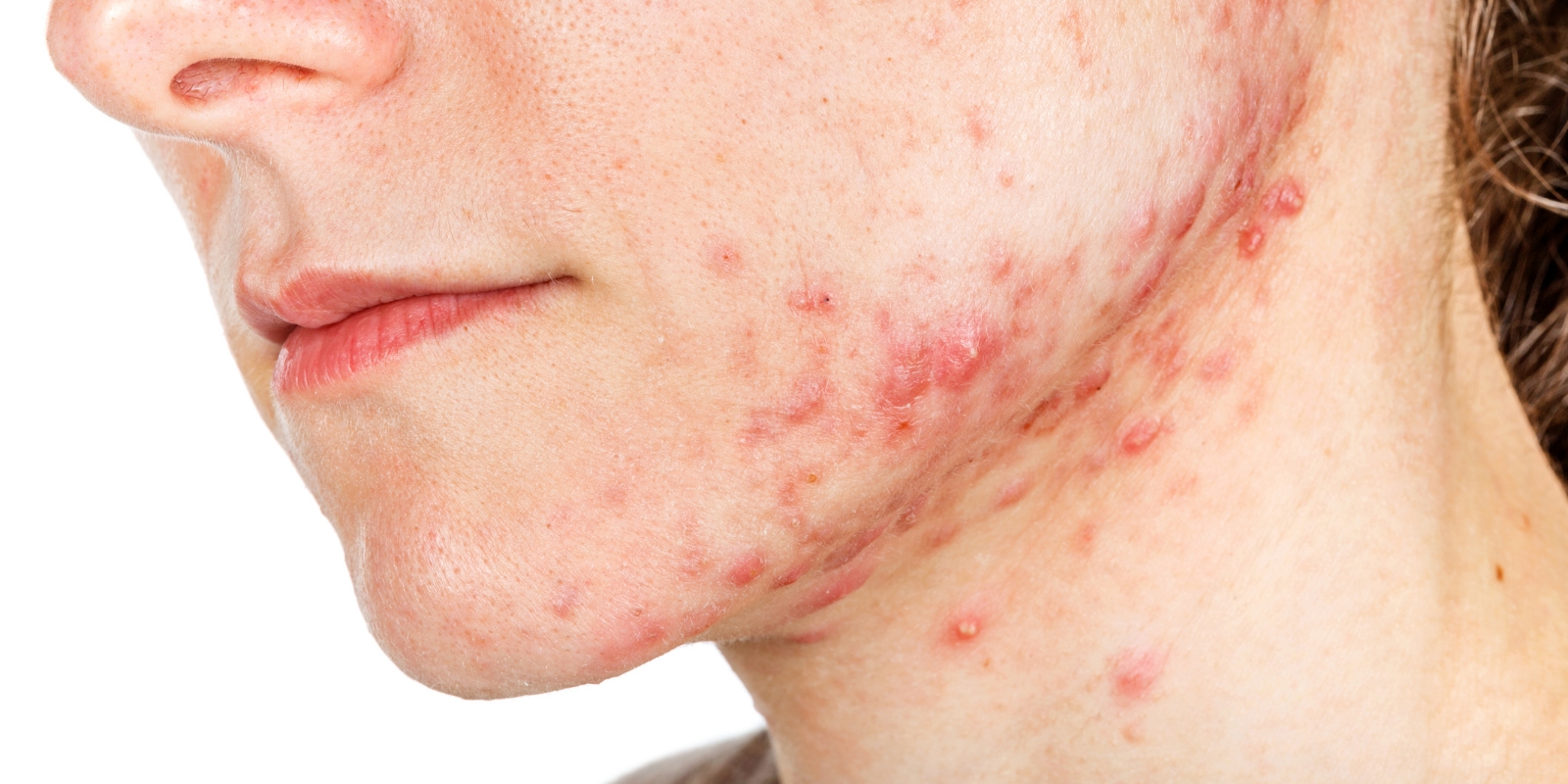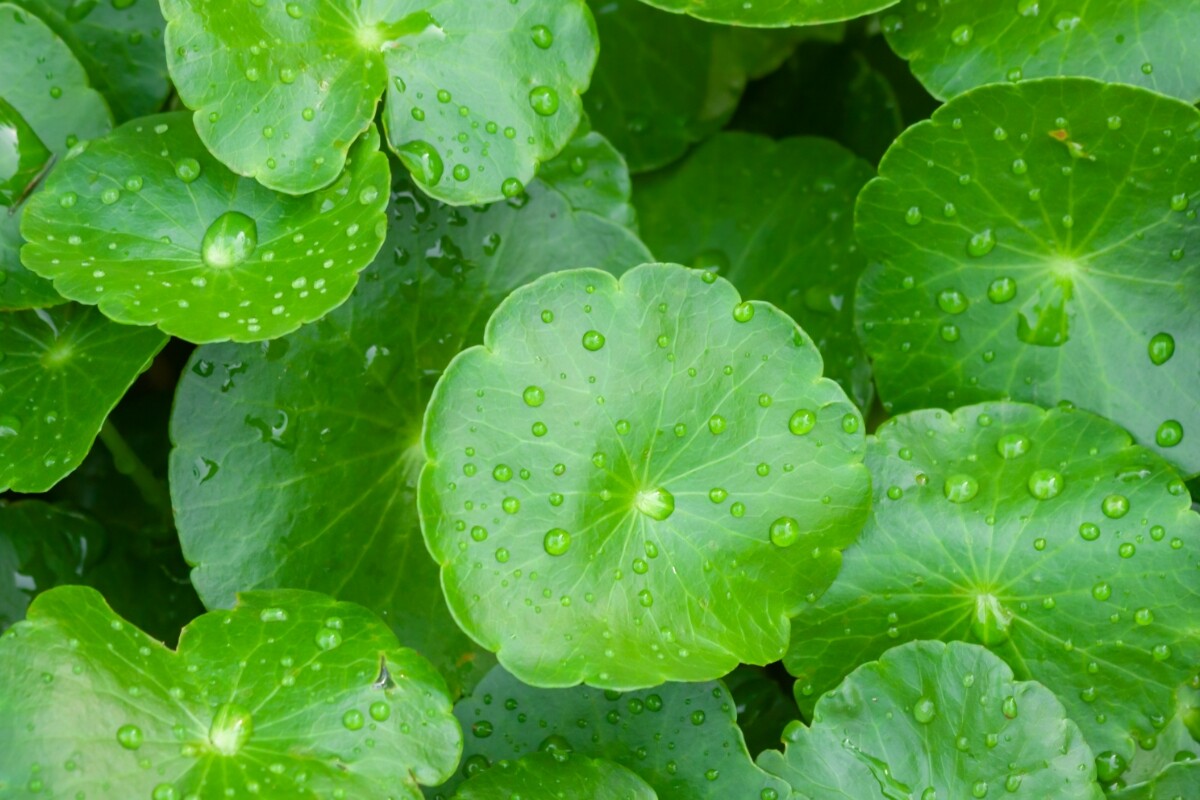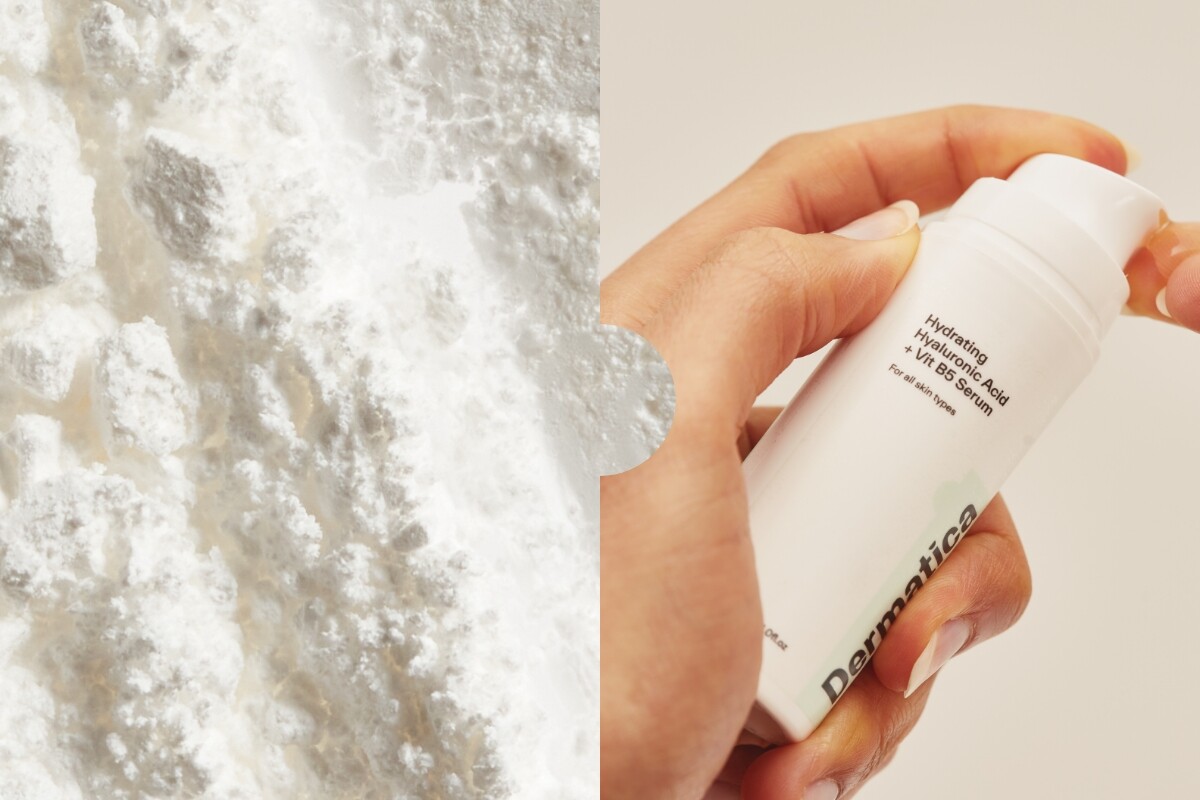There are plenty of videos online promising to clear jawline acne up, fast. But if you have this stubborn condition, you already know that treatment isn’t always so straightforward. Recurring jawline acne specifically appears around the lower cheeks, sides of the chin, and the neck. Breakouts can come in the form of blackheads, but are more often pimples that are either red or have a white head (pustule).
Although it’s a common skin condition, acne in this area can be frustrating. It may signal underlying factors that need to be changed, or imbalances in your skin that might need topical or oral medication. Read on to discover what causes jawline acne, what small changes you can try that can help, over-the-counter products that may clear symptoms, and – if nothing seems to work – what options a dermatology professional can offer.
“Why Do I Have Jawline Acne?”
Underneath your skin, there are tiny oil glands called sebaceous glands that produce oil. This oil is needed to lubricate and protect your skin. This oil reaches the skin’s surface through small openings known as pores.
When you have oily skin, your skin produces excess oil, and these pores are more likely to get clogged. Along with dirt and dead skin cells, this can not only lead to comedones (blackheads and whiteheads), it creates an environment where bacteria can thrive. When acne-causing bacteria is present in a pore, your body triggers an inflammatory response that results in a pimple.
Pimples are usually filled with pus and can appear as red solid bumps or with a white head. Acne can develop anywhere on the face, but we’ll explain what the main causes of jawline acne are below. (1)
Common Causes of Jawline Acne
Jawline acne can happen to anyone, and isn’t a sign of being unhygienic. Acne-prone skin is often genetic, and caused by the overproduction of oil by your skin’s sebaceous glands (oil glands), as well as the presence of acne-causing bacteria. Causes of jawline acne we often see are:
Hormones
Hormonal fluctuations can trigger jawline acne breakouts, especially at certain points of the menstrual cycle, perimenopause, menopause, or with conditions like polycystic ovary syndrome. Hormonal acne is often seen around the jawline (as well as the cheeks and mouth) and mainly affects women over the age of 25. These imbalances are due to elevated androgen hormones (male hormones) – which stimulate excess oil production in your skin, leading to deep, cystic acne and painful acne lesions. (2)
Stress
Studies show a potential link between hormonal imbalances and physical and psychological stress. When your body produces too much cortisol (the stress hormone), it can stimulate androgen production in the skin. As explained above, this makes your skin produce excess oil, triggering cystic acne breakouts. (3)
Medications
Oral contraceptives and HRT (Hormone Replacement Therapy) can also change your hormone levels, leading to hormonal acne from excess oil production in the skin.
Steroids may lead to an increase in sebum production. Taking corticosteroids can also suppress your immune system, making your skin more prone to infections and inflammation.
Shaving
Whether you’re wet shaving or dry shaving, it’s important to use a sharp, clean razor to avoid causing too much friction – especially if you have acne. Friction caused by frequent shaving with a dull blade can irritate sensitive skin and hair follicles (read more on this below), causing more breakouts and increasing your risk of scarring. You’re also more likely to cut yourself while using an old razor, causing inflammation in the affected area. Avoid shaving creams and oils that have comedogenic ingredients, as these can clog pores and lead to acne, too. (5)
Infected Hair Follicles (Folliculitis)
The small, pus-filled bumps associated with folliculitis may look like acne, but they’re only centred around hair follicles. They typically don’t include blackheads, nodules or cysts.
Folliculitis happens when certain bacteria infect the hair follicles, causing inflammation and small, itchy, pus-filled bumps. This can happen from frequent shaving or friction, for example from scarves, helmet straps or tight clothing. (6)
Skincare, Makeup & Mobile Phones
If your skin is sensitive or allergic to ingredients in some skincare and cosmetic products, they may make you more prone to clogged pores, irritation or reactions that lead to jawline acne. Using heavy, oil-based or comedogenic products have the potential to block pores, which fosters bacterial growth and acne breakouts.
It’s also important to clean any tools or objects that often come into contact with your face, such as makeup brushes, face cloths and mobile phones. These harbour acne-causing bacteria, sebum and dead skin cells. (7)
Treating Jawline Acne
Addressing jawline acne involves a combination of an effective skincare routine, lifestyle changes and potentially stronger treatments, recommended to you by a licensed dermatology professional or online service.
Building An Effective, Acne-Fighting Routine
The first step when dealing with jawline acne is to bring your skincare routine back to the basics. We always recommend choosing products that are fragrance-free, non-comedogenic, and compliant with NICE guidelines for sensitive skin.
Avoid comedogenic ingredients like mineral oils, essential oils or synthetic fragrances, as these increase the risk of clogging pores and irritating your skin. Don’t use too many active ingredients at the same time either, as you may overload your skin – causing irritation and making your condition worse.
As your baseline, you only need two products: a gentle, effective cleanser that removes dirt, impurities, makeup and sunscreen – and a lightweight soothing moisturiser that is suitable for oily or breakout-prone skin, and won’t clog pores. If you’re not sure what to use, try these products below.
Balancing Glycerin Gel Cleanser
Our gel-based cleanser has glycerin as a key ingredient, which is a well-known humectant that helps to hydrate the skin without leaving any residue or clogging pores. The gentle formulation cleanses the skin without stripping it of natural oils, making it suitable for all skin types.
It’s refreshing, soothing, suitable to use alongside active ingredients and formulated according to the NICE guidelines for sensitive skin.
Soothing Centella Gel Moisturiser
The main ingredient in our gel moisturiser, centella asiatica, is an antioxidant known for its calming and anti-inflammatory properties, which can help reduce redness and irritation. Formulated along with niacinamide, peptides and ceramides, this moisturiser can also help strengthen and repair the skin barrier.
The gentle gel formulation is suitable for all skin types, including sensitive, and works especially well for oily or breakout-prone skin.
Non-Prescription Treatments
Over the counter treatments are available without needing to go to a doctor or dermatology professional first. They often include either one active ingredient, or a combination of actives, precisely measured to suit your skin and where you are on your journey.
Services like Dermatica make accessing these treatments easy and affordable, and it’s all done entirely online.
Benzoyl Peroxide
Benzoyl peroxide fights inflammation and kills acne-causing bacteria. It also helps to unclog pores by exfoliating dead skin cells. The mild drying effect may also help reduce how oily your skin is overall. Start with the lowest concentration (2.5%-5%) to avoid irritation. Be cautious when you use it, as it has been known to bleach fabrics. (8)
Salicylic Acid
While it works slower than benzoyl peroxide, this BHA is effective at helping to reduce jawline breakouts, especially when combined with niacinamide. It works by penetrating the pores and dissolving any buildup of dead skin cells or excess sebum, which helps to prevent acne-causing bacteria. It’s anti-inflammatory, so it can help reduce redness and swelling. By gently exfoliating the skin’s surface, it can also speed up cell turnover and prevent clogged pores. (9)
Azelaic Acid
Suitable for all skin types, azelaic acid is a gentle yet effective active ingredient that can help calm inflammatory acne and support the reduction of acne breakouts. It’s a favourite among dermatology professionals, as products like our Clarifying Azelaic Acid Cream work in similar ways to retinoids – helping to speed up cell turnover (exfoliation), brighten dark spots and unclog pores. (10)
Topical Prescription Ingredients
Prescription treatments require you to go to a doctor or dermatology professional first. If you can access these services, it’s usually a safer option, as a dermatology expert will assess your skin first and create a treatment plan that’s personalised to your skin.
Personalised formulas often include either one active ingredient, or a combination of compatible actives, that suit your individual skin type and where you are on your journey to healthy skin.
Adapalene
This retinoid is available over the counter in some countries, but to avoid adverse reactions, we advise getting a professional to personalise the strength to your skin. A dermatology expert may also recommend a formula that combines adapalene with benzoyl peroxide for more effective results. (11)
Tretinoin
A prescription-only retinoid, tretinoin has a multitude of benefits for treating acne breakouts, as well as any post-inflammatory hyperpigmentation that may be left behind after an acne lesion has healed. (12)
Oral Medications
If a dermatology expert thinks you’re eligible, they may prescribe you with oral medications like doxycycline to speed up your results. This route could be a game-changer if you have severe acne that risks causing acne scars, or if topical treatments aren’t effectively clearing up your breakouts. (13)
Diet
Studies suggest there may be a link between the food you eat and whether you experience a breakout afterward, however results have been mixed and subjective. High sugar and high glycaemic-index (GI) foods, for example, may affect your hormonal balance and lead to acne. It’s something to keep in mind – as certain foods that may cause you to break out, may not trigger breakouts in someone else. (14)
Why It’s Important To Treat Jawline Acne
Untreated jawline acne can lead to persistent skin issues, post-inflammatory hyperpigmentation (dark spots), permanent scarring, and it may negatively affect your mental health. There are effective options out there for you, and a dermatology expert can help tailor a treatment plan to your specific needs to make sure you use products at the right strength for your individual skin.
By understanding the underlying causes and introducing a targeted, personalised treatment plan, you can effectively manage jawline acne and enjoy healthier, clearer skin.
To find out what formulas and treatment options might be suitable for acne, visit our website for more information.
References
1. Sutaria AH, Schlessinger J. Acne Vulgaris [Internet]. National Library of Medicine. StatPearls Publishing; 2019. Available from: https://www.ncbi.nlm.nih.gov/books/NBK459173/
2. Bagatin E, Freitas THP de, Rivitti-Machado MC, Ribeiro BM, Nunes S, Rocha MAD da. Adult female acne: a guide to clinical practice. Anais Brasileiros de Dermatologia [Internet]. 2019 Feb [cited 2019 Oct 28];94(1):62–75. Available from: https://www.ncbi.nlm.nih.gov/pmc/articles/PMC6360964/
3. Chiu A, Chon SY, Kimball AB. The response of skin disease to stress: changes in the severity of acne vulgaris as affected by examination stress. Archives of dermatology [Internet]. 2003 [cited 2019 Jul 24];139(7):897–900. Available from: https://www.ncbi.nlm.nih.gov/pubmed/12873885
4. Khunger N, Mehrotra K. Menopausal Acne – Challenges And Solutions. International Journal of Women’s Health. 2019 Oct;Volume 11:555–67.
5. Information NC for B, Pike USNL of M 8600 R, MD B, Usa 20894. Skin care for acne-prone skin [Internet]. www.ncbi.nlm.nih.gov. Institute for Quality and Efficiency in Health Care (IQWiG); 2019. Available from: https://www.ncbi.nlm.nih.gov/books/NBK279208/
6. Winters RD, Mitchell M. Folliculitis [Internet]. PubMed. Treasure Island (FL): StatPearls Publishing; 2020. Available from: https://www.ncbi.nlm.nih.gov/books/NBK547754/
7. Suh D, Oh H, Lee SJ, Kim HJ, Ryu HJ. Relationship between acne and the use of cosmetics: Results of a questionnaire study in 539 Korean individuals. Journal of Cosmetic Dermatology. 2020 Nov 30;20(7):2172–8.
8. Yang Z, Zhang Y, Lazic Mosler E, Hu J, Li H, Zhang Y, et al. Topical benzoyl peroxide for acne. Cochrane Database of Systematic Reviews. 2020 Mar 16;
9. Lu J, Cong T, Wen X, Li X, Du D, He G, et al. Salicylic acid treats acne vulgaris by suppressing AMPK / SREBP 1 pathway in sebocytes. Experimental Dermatology. 2019 May 15;28(7):786–94.
10. Sauer N, Małgorzata Oślizło, Brzostek M, Wolska J, Katarzyna Lubaszka, Katarzyna Karłowicz-Bodalska. The multiple uses of azelaic acid in dermatology: mechanism of action, preparations, and potential therapeutic applications. Postępy Dermatologii i Alergologii [Internet]. 2023 Jan 1 [cited 2024 Apr 28];40(6):716–24. Available from: https://www.ncbi.nlm.nih.gov/pmc/articles/PMC10809820/
11. Tolaymat L, Zito PM. Adapalene [Internet]. PubMed. Treasure Island (FL): StatPearls Publishing; 2020. Available from: https://www.ncbi.nlm.nih.gov/books/NBK482509/
12. Yoham AL, Casadesus D. Tretinoin [Internet]. PubMed. Treasure Island (FL): StatPearls Publishing; 2021. Available from: https://www.ncbi.nlm.nih.gov/books/NBK557478
13. Baldwin H. Oral Antibiotic Treatment Options for Acne Vulgaris. The Journal of Clinical and Aesthetic Dermatology [Internet]. 2020 Sep 1;13(9):26–32. Available from: https://www.ncbi.nlm.nih.gov/pmc/articles/PMC7577330/
14. Meixiong J, Ricco C, Vasavda C, Ho BK. Diet and acne: A systematic review. JAAD International. 2022 Jun;7:95–112.
Cat Hyatt
Dr Cat Hyatt is a GP, working as Clinical Content Lead for Dermatica. She has a special interest in medical content and making healthcare information accessible and understandable for all.





